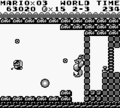Tamao: Difference between revisions
From the Super Mario Wiki, the Mario encyclopedia
Jump to navigationJump to search
TheDarkStar (talk | contribs) mNo edit summary |
No edit summary Tag: Mobile edit |
||
| Line 4: | Line 4: | ||
|species= | |species= | ||
}} | }} | ||
'''Tamao'''<ref>''Super Mario Land'' English instruction booklet, page 16.</ref><ref>''Nintendo Power'' Game Boy Player's Guide, page 5</ref> is an eyeball-like enemy that protects [[Dragonzamasu]] in [[World 2-3 (Super Mario Land)|World 2-3]] of ''[[Super Mario Land]]''. It bounces diagonally do different parts of the screen, damaging [[Mario]] if it touches his [[Marine Pop]]. Tamao is completely immune to torpedoes shot by the Marine Pop. However, once Dragonzamasu is defeated, Tamao disappears as well. | |||
'''Tamao'''<ref>''Super Mario Land'' English instruction booklet, page 16.</ref><ref>''Nintendo Power'' Game Boy Player's Guide, page 5</ref> is | |||
==Gallery== | ==Gallery== | ||
Revision as of 06:31, May 24, 2019
Template:Character-infobox Tamao[1][2] is an eyeball-like enemy that protects Dragonzamasu in World 2-3 of Super Mario Land. It bounces diagonally do different parts of the screen, damaging Mario if it touches his Marine Pop. Tamao is completely immune to torpedoes shot by the Marine Pop. However, once Dragonzamasu is defeated, Tamao disappears as well.
Gallery
Names in other languages
| Language | Name | Meaning | Notes |
|---|---|---|---|
| Japanese | タマオー[3] Tamaō |
Tama meaning "sphere". | |
| German | Tamao[?] | - | |
| Spanish | Tamao[?] | - |
References
| Super Mario Land | |
|---|---|
| Protagonists | Mario • Princess Daisy |
| Bosses | King Totomesu • Dragonzamasu (Tamao) • Hiyoihoi • Biokinton (Chicken) • Tatanga (Pagosu) |
| Locations | Sarasaland (Birabuto Kingdom • Muda Kingdom • Easton Kingdom • Chai Kingdom) |
| Levels | World 1-1 • World 1-2 • World 1-3 • World 2-1 • World 2-2 • World 2-3 • World 3-1 • World 3-2 • World 3-3 • World 4-1 • World 4-2 • World 4-3 • Expert Level |
| Items & vehicles | Super Mushroom • Superball Flower • Star • 1UP heart • Coin • Marine Pop • Sky Pop • Switch • Lift Block |
| Enemies & obstacles | Batadon • Bombshell Koopa • Bullet Biff • Bunbun • Chikako • Dropping lift • Falling block • Falling spike • Fly • Ganchan • Gao • Gunion • Goombo • Honen • Kumo • Mekabon • Nyololin • Pionpi • Pipe Fist • Piranha Plant • Pompon Flower • Roketon • Roto Disc • Suu • Tokotoko • Torion • Yurarin • Yurarin Boo |
| Other | Brick • Bonus game • Das Super Mario Spiel • Gallery • Glitches • Goal • Media • Mystery Block • Sub-area • Soundtrack |

